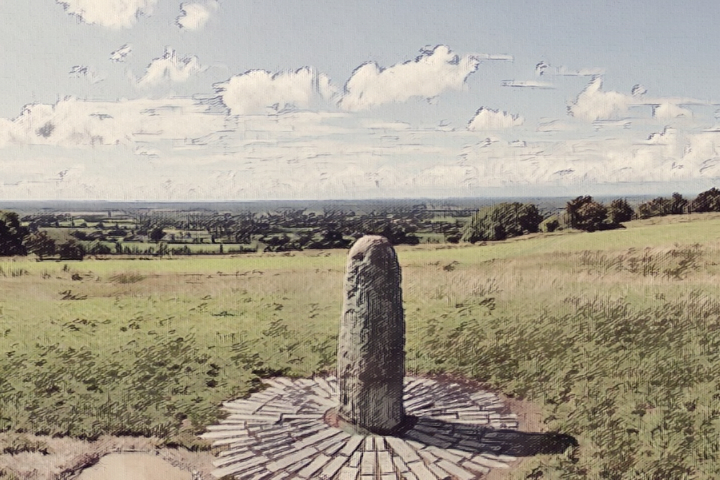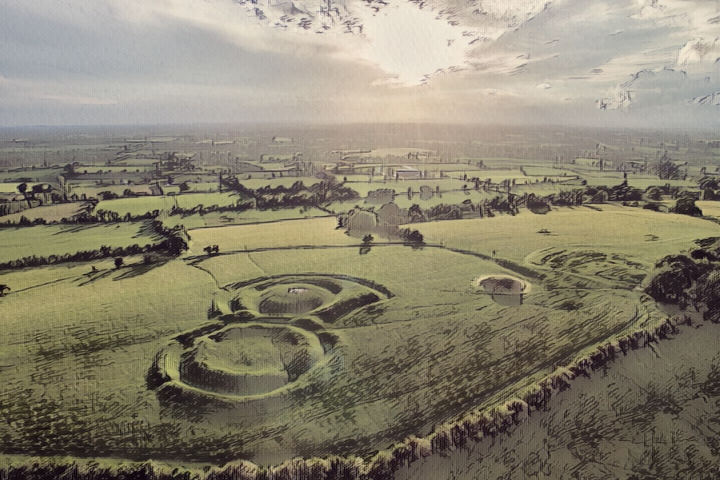
The Hill of Tara (Irish: Teamhair or Cnoc na Teamhrach) is a hill and ancient ceremonial and burial site located near Skryne in County Meath, Ireland. The hill is steeped in history and tradition, as it is believed to be the inauguration place and seat of the High Kings of Ireland. Additionally, it also appears in Irish mythology, adding to its significance. Tara consists of numerous monuments and earthworks, dating from the Neolithic to the Iron Age. These include a passage tomb (the “Mound of the Hostages”), burial mounds, round enclosures, a standing stone (believed to be the Lia Fáil or “Stone of Destiny”), and a ceremonial avenue. There is also a church and graveyard on the hill.
The name Tara is an anglicization of the Irish name Teamhair or Cnoc na Teamhrach, which translates to “hill of Tara”. It is also known as Teamhair na Rí, meaning “Tara of the kings”, and formerly also Liathdruim, which translates to “the grey ridge”. The Old Irish form of the name is Temair. It is believed that the name comes from Proto-Celtic *Temris and means a ‘sanctuary’ or ‘sacred space’ cut off for ceremony, cognate with the Greek temenos (τέμενος) and Latin templum. Another suggestion is that it means “a height with a view”.

The remains of twenty ancient monuments are visible on the Hill of Tara, and at least three times that many have been found through geophysical surveys and aerial photography. The oldest visible monument is Dumha na nGiall (the ‘Mound of the Hostages’), a Neolithic passage tomb built around 3,200 BC. It holds the remains of hundreds of people, most of which are cremated bones. In the Neolithic, it was the communal tomb of a single community for about a century, during which there were almost 300 burials. Almost a millennium later, in the Bronze Age, there were a further 33 burials – first in the passage and then in the mound around it. During this time, only certain high-status individuals were buried there. At first, it was the tomb of one community, but later multiple communities came together to bury their elite there. The last burial was a full body burial of a young man of high status, with an ornate necklace and dagger.

During the late Neolithic or early Bronze Age, a huge double timber circle or “wood henge” was built on the hilltop. It was 250m in diameter and surrounded the Mound of the Hostages. At least six smaller burial mounds were built in an arc around this timber circle, including those known as Dall, Dorcha, Dumha na mBan-Amhus (‘Mound of the Mercenary Women’) and Dumha na mBó (‘Mound of the Cow’). The timber circle was eventually either removed or decayed, and the burial mounds are barely visible today.
There are several large round enclosures on the hill, which were built in the Iron Age. The biggest and most central of these is Ráth na Ríogh (the Enclosure of the Kings), which measures 1,000 metres (3,300 ft) in circumference, 318 metres (1,043 ft) north-south by 264 metres (866 ft) east-west, with an inner ditch and outer bank. It is dated to the 1st century BC and was originally marked out by a stakewall. Human burials, and a high concentration of horse and dog bones, were found in the ditch. Within the Ráth na Ríogh enclosure, there is also evidence of structures such as houses and other buildings, suggesting that it was a fortified settlement. It is thought that the site may have been used as a royal residence or a ceremonial center. The other enclosures on the hill are smaller in size and may have been used for agriculture or as defensive structures. Overall, the hill of Tara is an important archaeological site that provides insight into the lives and cultures of the people who lived in the area during the Iron Age. The site is a significant cultural and historical landmark in Ireland and is open to visitors who wish to learn more about its rich history.
